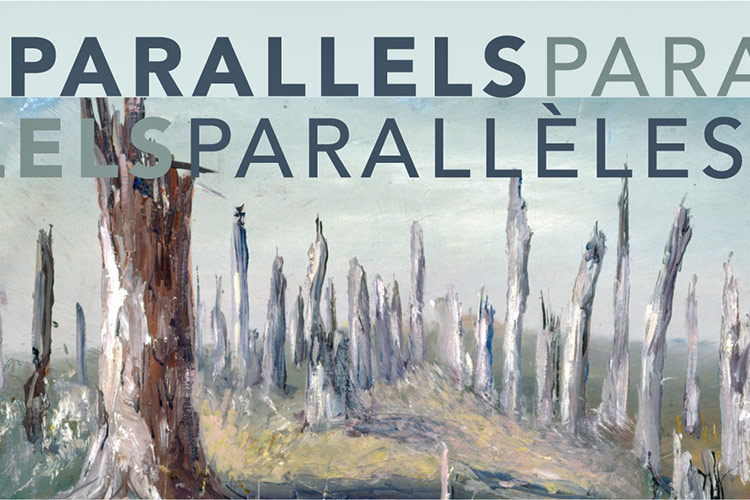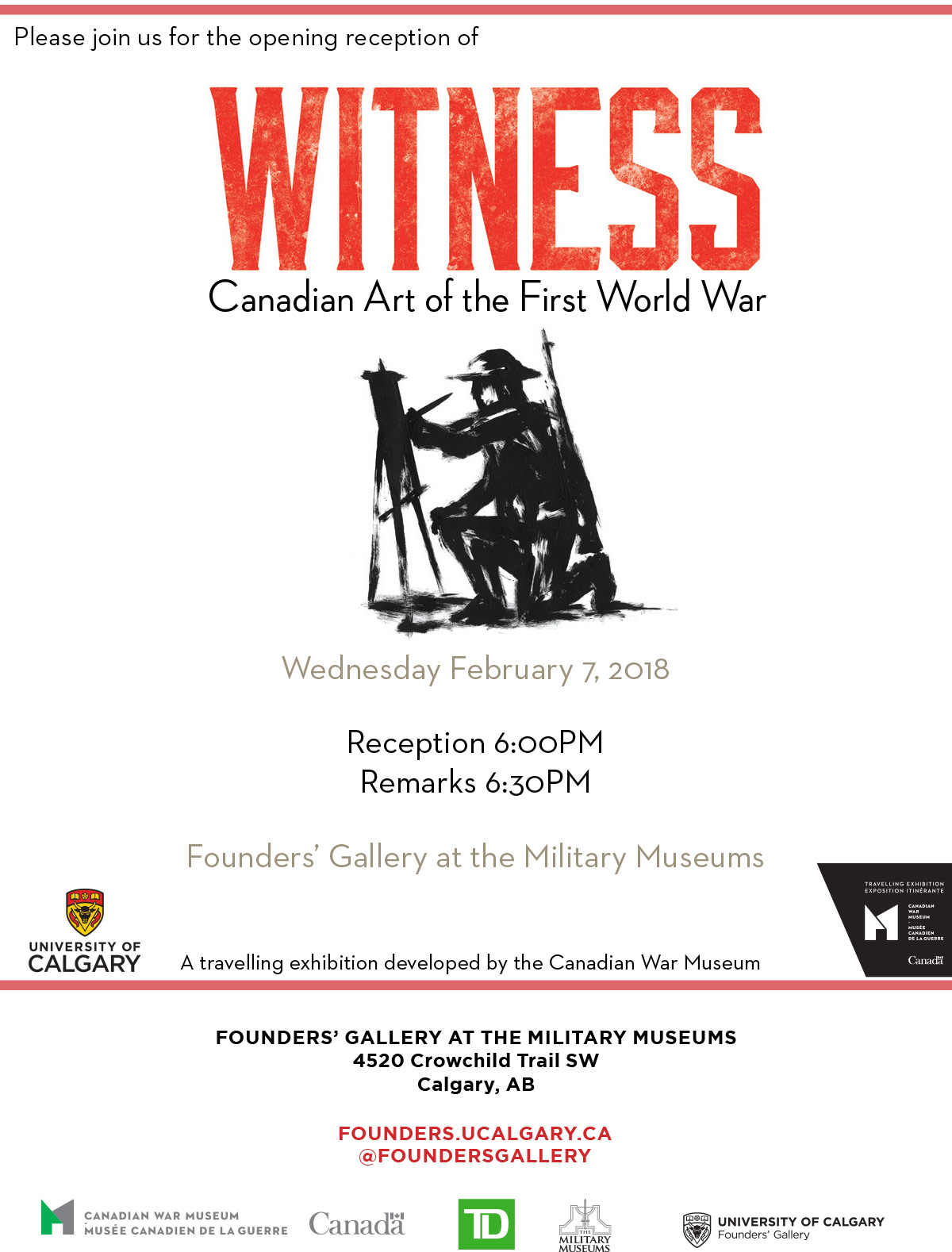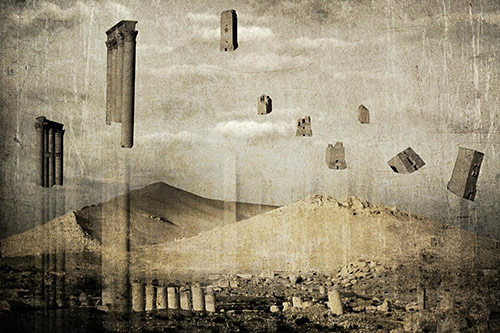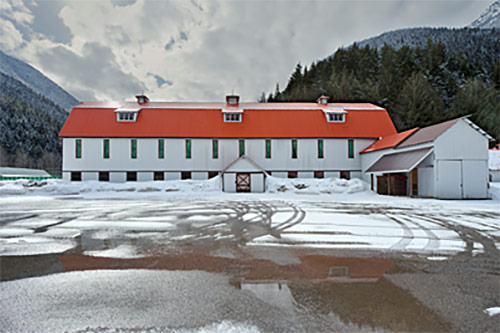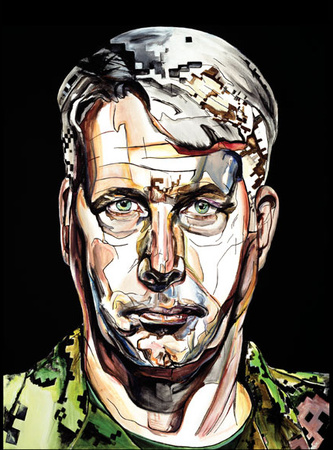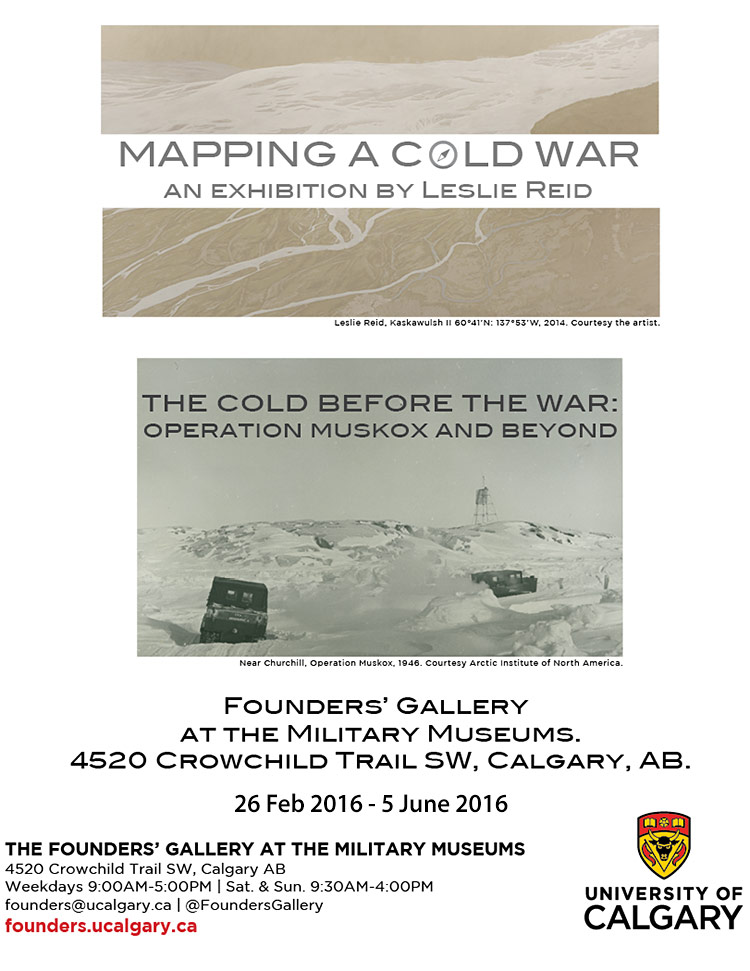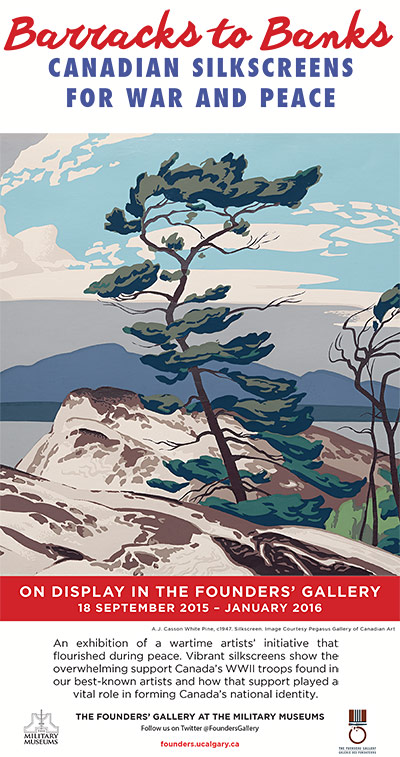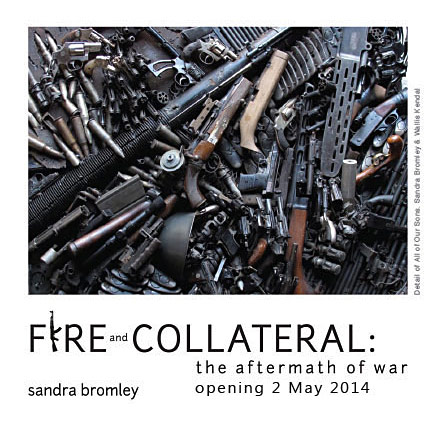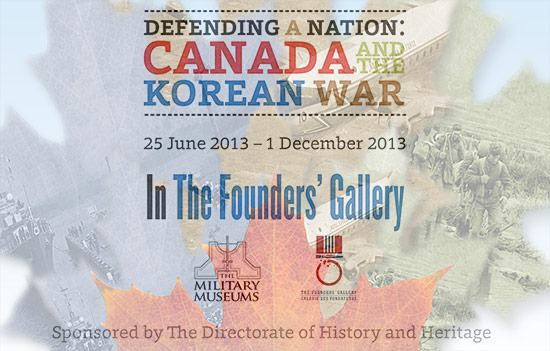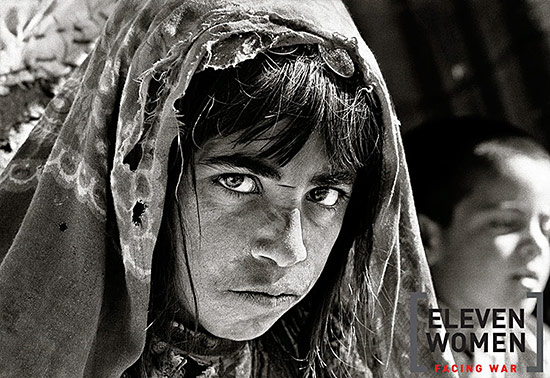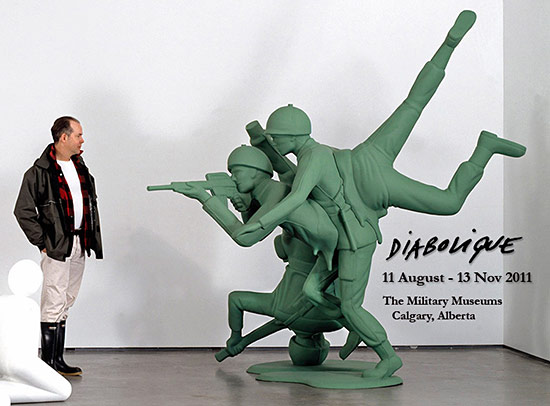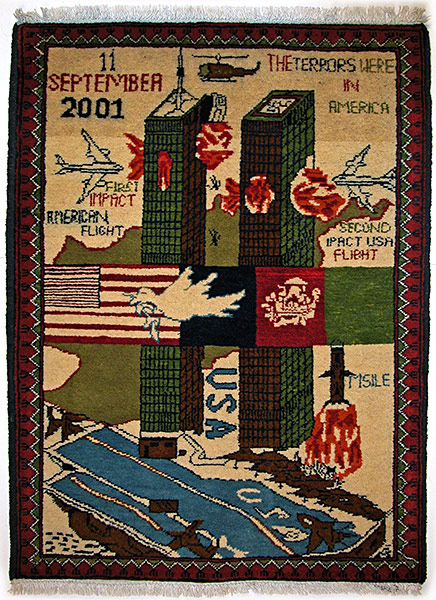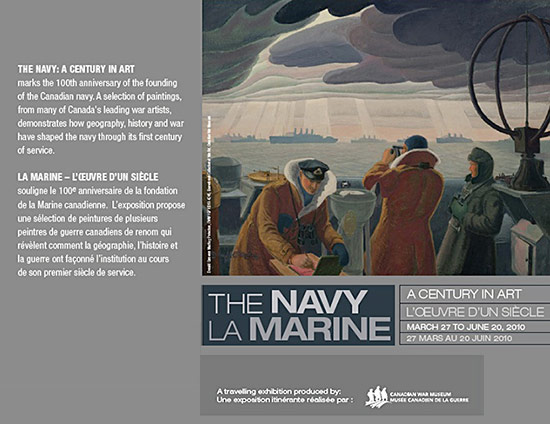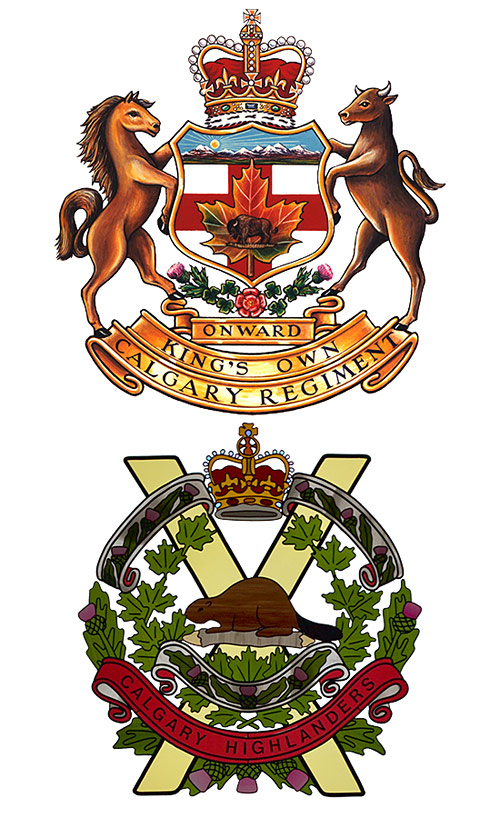
The Founders' Gallery: Past Exhibits 2009 - 2018
The Founders' Gallery has hosted several important art exhibits at The Military Museums since it opened in June 2009. These exhibits have helped Canadians understand and appreciate the significance of our military history through the display of contemporary works of art and artifacts.
The following is a list of exhibits that have taken place in The Founders' Gallery between 2009 - 2018.
The Founders' Gallery: Past Exhibits 2009 - 2018
Exhibits 2018
Öde
June 22, 2018 - Sept 23, 2018
ÖDE is an artwork created by the artist Sarah Beck. The work will continue to be an ongoing exhibit and is free to view outside the front entrance of The Military Museums.
This work address the idea of security as commodity versus security as human right and is meant to inspire conversation around access to defence. The inspiration for this work comes from the artist’s research into the Ghost Army of the Second World War. The Ghost Army was made up of artists who designed and painted inflatable decoy tanks to fool Nazi troops.
This project also stems from the artists research into Nazi tank training manuals. These manuals used advertising style motifs to quickly train German soldiers in the use of tanks. These manuals used catchy and easy to recall rhymes as well as drawn illustrations that reminded the artist of building instructions for furniture produced by companies like Ikea.
Gassed: Redux
June 22, 2018 - Sept 9, 2018
Adad Hannah created a new work based on the epic First World War painting, Gassed, 1919, by John Singer Sargent, now in the collection of the Imperial War Museum in London.
Adad Hannah is known for cleverly staged tableaux vivant videos that re-enact famous historical paintings and artworks. In this project, Hannah took inspiration from Sargent’s masterpiece and the regimental and archival collections at the Military Museums.
The artist worked with over 40 volunteers for 12 days to film Calgarians posed as the soldiers in the original painting, and to build a set with screens that combined monochromatic scene painting with mesmerizing contemporary video. Gas masks and printed material from the museums’ collections were also on display in separate vitrines.
Parallels: Women representing the Great War in Canada and Newfoundland
June 15, 2018 – July 31, 2018
Parallels: Women representing the Great War in Canada and Newfoundland
This exhibition looks at the contributions of women artists to the artistic representation of the First World War in Canada, and how their work was shaped by their position in Canadian society.
“Parallels” features the following artists:
- Landscape painter Mary Riter Hamilton (1867-1954) of Winnipeg and Vancouver
- Sculptor Frances Loring (1887-1968) of Toronto
- Portrait photographer Elsie (Elizabeth) Holloway (1882-1971) of St John’s NFLD
The exhibition includes several artefacts for display:
- Sculpting tools used by Frances Loring, generously on loan from a private donor
- A copy of “The Gold Stripe”, published by the War Amputations Club of British Columbia, the commissioner of Mary Riter Hamilton’s front line paintings
“Parallels” is presented by the Canadian Centre for the Great War, a charitable heritage organisation based in Montreal that promotes the social history of the First World War in Canada. Our travelling exhibitions have been crossing the country since 2017, and have appeared in the Winnipeg Free Press, the Calgary Herald, and Global Toronto, among others.
This exhibition has been made possible with funding from Heritage Canada, and the generous support of the Jackman Foundation. “We are extremely pleased to be able to highlight the work and wartime experiences of these talented women, and to bring their stories to Canadians” – Caitlin Bailey, Curator and Executive Director.
Witness: Canadian Art of the First World War
February 8, 2018 – May 27, 2018
Witness: Canadian Art of the First World War
Witness is a traveling exhibition developed by the Canadian War Museum. This exhibition contains 53 works by 40 of Canada’s best-known artists including AY Jackson, Arthur Lismer, Henrietta Mabel May, Paul Nash, Dorothy Stevens and Frederick Varley. What makes this exhibition truly unique, however, is that it also includes powerful and poignant works by ordinary Canadian soldiers. These works add to the totality of the powerful war record that we will present at the Founders’ Gallery.
One hundred years ago, artists and soldiers of the First World War used art to convey to Canadians what they had witnessed. In grappling with how to depict the unfamiliar sights -- tanks and gas attacks, dead and wounded fellow soldiers and friends, total destruction of the world around them -- some artists fit these new experiences within a familiar artistic framework. Others recognized and embraced the novelty of the experience finding new ways to depict the war. Today, these same works continue to help us understand and appreciate Canada’s role in this unprecedented global conflict.
The Battle of Moreuil Wood
February 8, 2018 – May 27, 2018
The Battle of Moreuil Wood: 100 Years of Heroism
Opening February 7, in commemoration of the centenary of the Battle of Moreuil Wood, is "The Battle of Moreuil Wood: 100 Years of Heroism" curated by the Lord Strathcona’s Horse (Royal Canadians) Regimental Museum. The Regiment was part of the Canadian Cavalry Brigade which, on March 30, 1918, defeated a German force at least twice its size. The battle in France resulted in heavy losses of soldiers and horses, with 53 of the Regiment killed, and a Victoria Cross being awarded to Lt. G.M. Flowerdew.
"We are excited to be able to showcase artifacts and stories from this heroic but not well known event in Canadian history. This is a battle which showcased the heroism, dash and skill of Canadian soldiers in the Great War, and we hope this exhibit will help bring their story to light for anyone who has yet to hear it." – Capt. Phil Webster, Curator, Lord Strathcona’s Horse (Royal Canadians) Museum
Exhibits 2017
Behind the Lines
October 12, 2017 – January 7, 2017
Behind the Lines
This exhibition aims to see the people of Syria through art and expand on the idea of Syria as conflict zone. Most of the 19 artists featured here still live in Syria. They come from places made familiar through news reports like Aleppo and Homs. Many are now in Damascus. Some have left Syria altogether.
The works reference the devastating situation in Syria or are informed by it. Humam Alsalim and Rami Bakhos’ Cultural Beheading series mourns and rages against both literal and metaphorical destruction. The body parts in Omran Younis’s paintings are a graphic reminder of the horrors of war. Those depicted in Lina Malki’s Displaced series have a palpable sorrow.
Fadi al-Hamwi’s large paintings of X-rayed cow hybrids convey animalistic brutality and how war provokes and exposes the dark side of humanity. Khaled Dawwa’s clay sculptures that appear to be vandalized or corroded by time are informed by his own experience: He was injured in a 2013 bombing, then arrested, imprisoned, and now exiled. Khaled Yousseff’s photographs of bubbles are tragic in their fragility yet childlike, as the artist says, make bubbles not war.
This exhibition is not for the faint of heart, but it also affirms the incredible capacity of the human spirit to not only survive the most unimaginable circumstances, but thrive. For those still living in Syria there are few opportunities to exhibit and as such they have nothing left to lose and are making art for the sake of art. Individually and collectively their powerful work stands as a testament to their existence and hopefully will inspire similar voices not only in Syria but also here in Canada. This exhibition is meant to build a greater understanding of the Syrian People, their art, rich culture, history and the turmoil their country is undergoing.
This exhibition was curated by Paul Crawford, Art Gallery of Penticton and Humam Alsalim, Cyrrus Gallery of Contemporary Syrian Art.
War Stories 2017
April 9 - August 27, 2017
War Stories: 1917
Personal stories from the battles of 1917 will be on display in The Founders’ Gallery from April 9 to August 27, 2017 at The Military Museums in the new exhibition, War Stories 1917. This exhibit commemorates the 100th anniversary of the battles of 1917: Vimy, Hill 70 and Passchendaele. It will tell the story of these battles through the eyes of the men and women who were there.
The exhibit includes John George Pattison's Victoria Cross and a Red Ensign flag flown at Vimy (on loan from the Imperial War Museum in England). War Stories 1917 connects Canadians to the personal experiences of people like those of Mike Mountain Horse, Major General Sir David Watson and Major Talbot Papineau.
This exhibition marks the first time all seven regimental galleries in the Military Museums, the Military Museums Foundation, the University of Calgary's Founders' Gallery and the University of Calgary's Library and Archives at the Military Museums have collaborated on a single, facility-wide exhibition.
Adding another dimension to the displays, the University of Calgary's Founders' Gallery will feature contributions by contemporary artists: Jason Baerg, Dianne Bos and Adrian Stimson. Their works include artistic portrayals of the battles of 1917 and representation of Indigenous participation in the First World War.
The artifacts in War Stories 1917 come from the The Military Museums' own collections, private collections, the Glenbow, the Canadian War Museum, Canada Science and Technology Museum, and the Imperial War Museum in England.
Soldiers Stories: 1917
War Stories 1917 allows Canadians to connect with the personal stories of the men and women who lived and died in those battles and who left an indelible record of their experiences that has helped to shape our understanding of these momentous events in our history. Some of the stories of Canadians who served during these battles are highlighted in this exhibit:
- Arthur Bell
- George Berry
- Blain Brothers
- Nick Carter
- John Carvosso
- Wilfred Curtis
- Joseph Fall
- Gordon Graham
- Huntly Ketchen
- Kinross, Mullin, McKenzie
- Conrad Lally
- William McLaren
- Mike Mountain Horse
- Redford Mulock
- Alfred Neil
- Jim Nicoll
- Henry Norwest
- Page Ormand
- Talbot Papineau
- John and Henry Pattison
- Ethel Paytner
- Harold Prichett
- Canon Scott
- Archie Sheffield
- Benjamin Skinner
- Robert Spall
- Thomson Brothers
- Sid Unwin
- David Watson
- Victor Wheeler
- Thomas Williams


CHALK
Thursday, July 20, 2017 - 6:30pm to 8:00pm
CHALK: a performance by Adrian Stimson
CHALK is a performance by Adrian Stimson in response the 100th anniversary of the Battle of Vimy Ridge. During the First World War, an extensive network of tunnels was dug through the chalk around Vimy Ridge. These tunnels offered shelter for Canadian soldiers, moved them towards the front, and made it possible to bomb underneath German lines.
The chalk tunnels were also artistic medium for those soldiers who lived, worked and fought in their claustrophobic quarters. With 100 bullets carved from chalk, Stimson will create a work directly on the wall of the gallery. The resulting drawing will remain on display with the exhibition War Stories 1917, in the Founders’ Gallery at the Military Museums until August 27, 2017.
Registered
November 11, 2016 to March 5, 2017
REGISTERED: The Japanese Canadian Experience During World War II
This exhibition of photographs and archival material explore the experience of Japanese Canadians during World War II when they were registered, rounded up and removed.
REGISTERED includes newspaper clippings from the 1940s, authentic registration cards, and interpretive photographs of buildings where the story unfolded. An exhibition by Leslie Hossack.
H-Hour: Normandy 1944
December 2, 2016 to March 5, 2017
H-Hour: Normandy 1944
The latest series of work explored by photographer Leslie Hossack explores the structural remains of the Atlantic Wall – giant bunkers and fortifications, largely hidden by the blowing sands of the D-Day beaches.
It also commemorates individual grave markers of the soldiers killed in 1944 and buried in Canadian, British, American and German cemeteries scattered throughout Normandy, as well as many original documents related to their tragic deaths. An exhibition by Leslie Hossack.
Exhibits 2016
Play Hard: Fight Hard
1 July 2016 to 13 November 2016
Play Hard: Fight Hard: Sport In The Canadian Military
Play Hard, Fight Hard is a ground-breaking exhibit that explores the relationship between sports and military service and how concepts like teamwork, leadership, physical fitness, and tactical planning are shared between the two worlds.
Play Hard, Fight Hard was created in partnership between The Military Museums (TMM) and Canada’s Sports Hall of Fame (CSHoF).
Throughout Canada’s history scores of athletes have gravitated toward military service, in times of war and peace. Similarly, traits and training that result from military service have allowed many athletes to enjoy success in sports after their military careers.
Play Hard, Fight Hard features over 200 artifacts, and personal stories of many Honoured Members represented in the CSHoF who proudly served in all branches of the military.
Dozens of sports are featured with their connection to military service, from the Great War to Afghanistan and from hockey to biathlon. Also featured are programs such as Soldier On, which uniquely combines military service and athletics. Soldier On is a Canadian Forces Moral and Welfare Services initiative that supports serving members and veterans in overcoming physical or mental health illness or injury through physical activity and sport.
One of the more well-known figures of the Soldier On Program, and featured in Play Hard, Fight Hard is Mark Fuchko. After having both legs amputated as a result of an IED explosion in Afghanistan, Mark has gone on to climb Mt. Kilamanjaro, plays sledge hockey, and has gone sea kayaking among other activities in the program.
One very unique sport featured in the exhibit highlighting the importance of sport in military service is Broom-i-loo. This uniquely military and often very rough sport is played traditionally only by the Princess Patricia’s Canadian Light Infantry, but famous across the Canadian Armed Forces. Broom-i-loo is a particularly rough, full contact broomball-football-hockey hybrid, played between the companies and battalions of the Regiment to build espirit de corps and to foster cohesion among the troops.
After its stay at The Military Museums, Play Hard, Fight Hard will be at Canada’s Sports Hall of Fame in 2017. From there the exhibit will travel across Canada, in full sized and scaled down versions. Museums interested in booking the exhibit can click here.
The Art Of Command: Portraits And Posters From Canada’s Afghan Mission
4 July 2016 - 30 October 2016
The Art of Command: Portraits and Posters from Canada’s Afghan Mission
The Art of Command is a solo exhibition by Gertrude Kearns, Canada’s leading contemporary war artist. This exhibition examines the roles of specific highly ranked individuals who not only fought in but commanded Canada’s war in Afghanistan.
Her work focuses on the complexities and consequences of military command in challenging situations, and reveals the inner struggles of those at the Afghan operation’s highest levels.
This exhibition is not mere homage to Canada’s mission in Afghanistan; it’s a reflection of the effects war has on those who call the shots on the front lines. The Art of Command takes viewers—military and civilian alike—on an emotional journey, through the presentation of fearless, self-assured and ruthlessly honest portraits of military subjects.
Mapping a Cold War
26 February 2016 - 5 June 2016
Mapping a Cold War and The Cold Before the War
Mapping a Cold War is an exhibition by contemporary artist Leslie Reid. Made through a residency with the Canadian Forces Artist Program, this exhibition highlights the complex yet often ignored role that the north plays within Canada and the entwined nature of defence and environment. A palimpsest of historic and contemporary photography, painting and video show past and present relationships between northern populations, northern landscapes, and government and military activities.
The Cold Before the War is inspired by the works of Leslie Reid and draws heavily on the archival collections of the Arctic Institute of North America to showcase Operation Muskox of 1946, one of Canada's first arctic operations.
Exhibits 2015
Barracks to Banks: Canadian Silkscreens for War and Peace
18 September 2015 - 17 January 2016
Barracks to Banks: Canadian Silkscreens for War and Peace
During the Second World War, Canadian painter and official war artist A.Y. Jackson initiated an innovative project between the National Gallery and the Department of National Defence, allowing artists to support soldiers with art. Starting in 1942, vibrant landscape silkscreens by A.J. Casson, Emily Carr, Charles Comfort, Lawren Harris, A.Y. Jackson, J.E.H. MacDonald, David Milne, and 47 others were sent across the country and around the world to beautify the living quarters of soldiers who were far from home, remind soldiers what they were fighting for, and instill a sense of national pride.
After the war, these prints became extremely popular within Canada. They were purchased for banks, schools, libraries, post-offices, and many other public buildings in large centres and small villages from coast to coast. Barracks to Banks will show not only the massive support Canadian troops found in Canada’s best-known artists, but also how that support played a vital role in the formation of Canadian national identity.
With the goal of making contemporary art accessible to all Canadians at home and abroad, this project became so successful that their eventually omnipresence undervalued their historical and cultural importance. Several of the silkscreens have now been lost and many are becoming increasing rare. This silkscreen project was, however, the primary, if not only, way that most post-war Canadians interacted with contemporary art and continues to shape Canadian art, inspiring many artists including Douglas Coupland.
The prints, meant to visually summarize Canada, became so popular following the Second World War, that this project is widely credited as the impetus for the creation of the Canadian Flag, one iconic visual symbol under which all Canada could unite. A unification that is still ongoing, Barracks to Banks shows the past and present struggle to visually and symbolically represent all lands and all people within the vast and varied country of Canada.
As the prints were meant for immediate public distribution, many have never before been shown together. Following a massive research project and the publication of best-selling Art for War and Peace, the prints have been collected and will now be shown along with many paintings they relate to, including AJ Casson’s iconic White Pine—the silkscreen version predating the oil by nearly 10 years.
Over 100 items, mostly silkscreens, will be shown in Barracks to Banks: Canadian Silkscreens for War and Peace. Silkscreens, paintings, photographs, stamps, posters and other items in the exhibition come from sources all over Canada including the Canadian War Museum, the McMichael Canadian Art Collection, Libraries and Archives Canada, Pegasus Gallery of Canadian Art, and many generous private and corporate donors. Barracks to Banks will enliven further interest and research into this forgotten artists’ initiative that was initiated in wartime and flourished during peace.
The Maple Leaf And The Tulip
6 May 2015 - 16 August 2015
The Maple Leaf And The Tulip: The Liberation Of Holland In The Second World War
This exhibit includes artifacts and photos related to members of the Canadian military serving in the Netherlands in the Second World War, as well as to Dutch civilians and members of the Dutch Resistance. Video oral history interviews will also be shown as a central part of the exhibit, to let visitors understand the firsthand experience.
The exhibit will open May 5, 2015, coinciding with the 70th anniversary of the final campaign to liberate the Netherlands. Full coverage of Canadian involvement in the Netherlands will be showcased, including the reduction of the Breskens pocket, the clearing of the Scheldt estuary, and the final campaign in 1945 towards Apeldoorn and beyond. Operation Manna, the resupply of the starving Dutch populace at the end of the war, will also be featured.
The exhibit will feature artifacts contextualized by large wall graphics (photos and art) and will include some never before seen photographs, as well as art from the Beaverbrook collection at the Canadian War Museum. Original art on loan from the Canadian War Museum will include well known official war artists such as Alex Colville and Charles Comfort.
The exhibit continues the strong bond between Canada and the Netherlands, and will feature artifacts on loan from museums and private individuals in the Netherlands. The Dutch community has supported the exhibit financially, and have shared their stories and objects. Artifacts on loan from the Glenbow Museum in Calgary and the Canadian War Museum in Ottawa will also be included.
Dutch War Brides
6 May 2015 - 16 August 2015
Dutch War Brides Trees Heeft een Canadees by Beverley Tosh
Trees Heeft een Canadees, (Teresa Has A Canadian) is a popular song in the Netherlands about Dutch women who fell in love with Canadian soldiers during the Second World War.
After their brief romances and often ad-hoc weddings in Holland, the soldiers returned to Canada. Not permitted on the soldiers’ ships, the young Dutch wives waited often a full year in the Netherlands before boarding their own ships to re-join their husbands in Canada. Most of these women never saw their families again. Many, speaking mostly only Dutch, moved unknowingly from metropolitan centers in the Netherlands to isolated prairie settlements. However, the occupation had strengthened these women’s resolve and many had no choice but to persevere and build new lives in Canada.
In this exhibition, artist Beverley Tosh shares these women’s stories, their life during the occupation, their weddings in Holland, and their one-way passages to Canada. With her most recent body of work, Tosh shares the stories of Dutch-Canadian war brides, conveying both the romance, and the hardships endured by these women.
This exhibition will consist of 24 wedding portraits and stories of Dutch women meeting their Canadian soldiers, all researched by Beverly Tosh, herself a daughter of a war bride. The exhibition also includes an original wedding dress worn by one of the women, “The Little Coat” from the collection of the Canadian War Museum, and documents, photo’s and films conveying the deep connections between Canadian soldiers and the people of Holland.
Burnt Generation
9 January 2015 - 12 April 2015
Burnt Generation
Burnt Generation is an exhibition of contemporary Iranian photography – most of which has not previously been seen in North America. The Burnt Generation in Iran are those who, roughly born between 1970 and 1990, experienced the 1979 revolution, the 8 year Iran—Iraq war, and the political and social consequences of these events.
This exhibition seeks to convey the impact of those decades of political unrest and social upheaval upon the Iranian people. The exhibition is a rare opportunity to move to a place beyond cliché; a moment to forget the stereotypical images of Iran and enter the world’s of eight highly original and intellectually engaged image makers.
Featuring documentary photography, portraiture and fine art photography Burnt Generation has three central themes: the isolation, loneliness and dissolution of youth; the common threads that unite the Nation in spite of everything; and the personal, political and social consequences of war. Burnt Generation is curated by Fariba Farshad, Director of Candlestar, London, UK.
Photographers:
Ali Nadjian and Ramyar Manouchehrzadeh
Azadeh Akhlaghi
Babak Kazemi
Gohar Dashti
Abbas Kowsari
Newsha Tavakolian
Shadi Ghadirian
Sadegh Tirafkan
Exhibits 2014
#EuromaidanYYC
28 July – 15 December 2014
#EuromaidanYYC by Tomas Rafa
Social media has remoulded human maidaninteraction and changed the way we come together, go to war, protest, and create change. #euromaidanYYC shows the ongoing Ukrainian protests and unrest originating in Maidan Square, Kiev.
The protestors organized themselves through popular social media sites like Twitter and Facebook and the entire movement soon took on the name of its Twitter hashtag, Euro Maidan.
Photographer and filmmaker Tomas Rafa works on the boundaries between patriotism and nationalism. His work focuses on multiculturalism, xenophobia, extremism and neofascism situated against the background of everyday life. #euromaidanYYC shows both pro-Russian and pro-European manifestations in Ukraine.
Citizens who want their country to align more closely to Europe championed the Maidan Square protests. The Siege of Sloviansk was a pro-Russian retaliation by citizens who want the country to have stronger ties to Russia.
Rafa’s documentation shows a cinematic quality to this unrest. In his photographs, the average Ukrainian citizen takes on the role of hero in his or her own life featured within the pictorial backdrop of both Maidan (or Independence) Square and Sloviansk in East Ukraine.
Wild Rose Overseas: Albertans In The Great War
28 July 2014 – 15 December 2014
Wild Rose Overseas
A young province’s march to war is explored through Wild Rose Overseas artefacts, personal stories and important works of art. From training to the trenches, from demobilization to homecoming, this heritage exhibition tells the story of Alberta’s major units during the war.
Some of the unique artefacts included are items related to well-known airman Wop May, an extremely rare complete WW1 naval uniform, and a pigeon message canister. Artworks will include paintings by Inglis Sheldon-Williams.
Wild Rose Overseas: Albertans in the Great War opens 28 July 2014 in The Founders’ Gallery at The Military Museums coinciding with the centennial of the war’s outbreak.
 Sponsored by the Alberta Museums Association.
Sponsored by the Alberta Museums Association.
Fire Collateral
2 May 2014 - 1 July 2014
Fire and Collateral: The Aftermath of War explores the lingering trauma that follows violent conflict
Nothing in our modern world prepares you for the traumas of war; the violence and suffering challenge hope and trust in humanity. The exposure bruises the soul. Travelling to Sierra Leone shortly after its long and brutal civil war shocked me, but what I experienced there also inspired me to try to penetrate this darkness and reveal the remarkable and enduring light of rebirth and resiliency.
In our contemporary sound-bite-and-social-media-saturated lives, it is easy to forget that the conflict stories in the news are actually about ordinary people, so much like us, trying to survive in the face of unimaginable odds. They face real consequences and must endure immense personal sacrifices simply to exist.
In these installations I have attempted to share their reality visually and without adornment; let their bearing, eyes and voice tell their stories.
The Innocent installation includes children and youth that I met and interviewed while working in Sierra Leone. All had to work long hours to survive. Some were fruit sellers, diamond mineworkers, labourers, apprentices. Some were former child soldiers or young bush wives (sex and labour slaves). The children here stand alone, but joined together by guns and a chain, each conveys a different level of engagement.
The 4 Doors: Kadeer, Mohamed, Kamara, Cecilia installation invites engagement, or at the least the conscious acknowledgment of the individual and their existence. You can chose to observe the artwork, to watch the silent videos or to engage the artwork and open a door that will release the voice of Kadeer, Mohamed, Kamara or Cecilia to tell of their life experiences. I have chosen to not translate their stories as it was important to sustain and honour the individuals as they are.
Sierra Leone has returned to relative peace, yet its people must now cope with the massive need to piece together traumatized lives and rebuild the most basic infrastructure. Sierra Leone is not unique … the effects of any war are a long and tragic legacy. It is easy to forget that wars do not disappear as they are replaced by new media events. They have a lasting and ongoing effect on ordinary people and their cultures. These artworks reflect, honour and attempt to activate the lessons learned of the world wars, “Lest We Forget.”
The “Gun Panels” were created with deactivated weapons left out of the making of the Gun Sculpture, a five-ton touring exhibit. The intent of the “Gun Panels” and the Gun Sculpture is to provoke discussions on violence.
-Sandra Bromley, artist
(Re)Constructed Warship
2 May 2014 - 1 July 2014
(Re)Constructed Warship: Technical Speculations Of Grand Naval Monuments
A test of skill in the service of painstaking historical accuracy meets total fabrication and a disregard of any semblance of literal depiction. The works of Richard Edwards and Chris Flodberg clash in their artistic approach to the same issue: How does an artist, at the mercy of human scale, render monumental emotionally charged machinery “realistically”? Both Edwards’ and Flodberg’s painterly practices are translated onto complex three-dimensional canvases, resulting in the iconoclasm of their naval ship constructions.
Edwards’ sculptures are collage, pieced together in a modernist style, showing not only a perception of a ship but the constructed memory of human relationships to monolithic artifacts. His constructions are reminiscent of both Dazzle Camouflage rendered sculpturally as well as early modernist painting that struggled to render the technological advances brought about by the First World War.
Flodberg applies his meticulous skill of painting to that of the canvas of historical model making. He pays as much attention to the reading of how shadow and light would play at a 1,000 metre distance to the historical research into the accuracy of the lifeboats of a Second World War battleship.
One artist uses the model as a base for the most complex of painting, the other uses the techniques of painting to create models. Both present the folly of these ships. Created by military hubris, the Second World War battleships were obsolete before their constructions were finished—most now rest at the bottom of the ocean. Both renderings are fabrications.
Photography and historical record of battleships are by no means comprehensive, so even Flodberg’s attempts at historical perfection are doomed before they begin. Artistically, they are memento mori in the greatest sense. Flodberg’s pieces are majestic and statuesque monuments to fallen ships, while Edwards ephemeral cardboard works sit unprotected as unfinished facades.
-Lindsey V. Sharman, curator
Forging A Nation
22 January 2014 - 7 April 2014
Forging A Nation
2014 marks the centennial of the start of the First World War and is also the 100th anniversary of the formation of many of the regiments that were mobilized for this conflict.
Canadians’ individual and collective contributions and sacrifices to this war changed Canadian history and continue to shape notions of Canadian national identity to this day. Despite Canada’s contributions in tandem with allied countries, it was not until after the collective traumas of the First World War that any notions of nationalism were felt at all.
In the vast and diverse country that is Canada, there is little that ties Canadians together beyond collective war efforts, uniting those on the home front, both in support as well as opposition. Artists have been an important part of the Canadian Military and many of Canada’s best-known historical artists were on the front lines depicting the key events of the First World War.
Forging A Nation: Canada Goes to War depicts the remarkable events of this war and the following 100 years of violent conflict as captured by military, civilian, Canadian, and foreign artists. These artists portray the experiences of ordinary Canadians who endured the extraordinary.
Artists in the exhibit include:
| Dick Averns | John William Beatty |
| William Bewick | Isla Burns |
| Bertrand Carrière | John de Chastelain |
| Alex Colville | Charles Comfort |
| Maurice Cullen | Orville Fisher |
| Kenneth Forbes | Colin Gill |
| John Heartfield | Gershon Iskowitz |
| A.Y. Jackson | Franz Johnson |
| Gertrude Kearns | T.R. MacDonald |
| Jack MacLaren | Pegi Nicol MacLeod |
| William MacDonnell | Allan Harding Mackay |
| David B. Milne | Paul Nash |
| W.A. Ogilvie | Charles Oppenheimer |
| R. Mae Pey | Albert Richards |
| Paul Seguna | Inglis Sheldon-Williams |
| Tony Scherman | Gordon Appelbe Smith |
| Michael Smith | SM Steele |
| Katherine Taylor | Peter von Tiesenhausen |
| Frederick Varley | Robert Venor |
| Scott Waters | Robin Watt |
| William Wessel | William Barnes Wollen |
| Ted Zuber |
Exhibits 2013
Defending A Nation: Canada And The Korean War
25 June 2013 - 1 December 2013
Defending A Nation: Canada And The Korean War
Canada devotes a significant amount of attention to its living veterans from the Second World War, and to that conflict in general, but those from the Korean War have not been given the full recognition that they deserve.
This exhibit will tell the story of the major battles that Canadians were involved in during the war in their context as a United Nations mission and as part of the Cold War, and the stories of the major Canadian units that served there.
A key component of the exhibit will be audio and video interviews with Korean War veterans telling their stories in their own words. The exhibit will be tri-service, including information on the involvement of the navy, the army and the air force.
Souvenirs, firearms, uniforms, medals groups and high quality art will be presented, including items related to the Canadian commander of the 25th Canadian Infantry Brigade, Brigadier General John Rockingham, and the only individual taken prisoner from the air force, Squadron Leader Andrew MacKenzie.
Eleven Women Facing War
8 August 2013 - 2 December 2013
Eleven Women Facing War
Eleven Women Facing War tells eleven stories of women from Afghanistan, Sierra Leone, Colombia, the Balkans, Israel and the Palestinian territories. Internationally renowned photographer Nick Danziger initially photographed these women in conflict zones for an International Committee of the Red Cross study in 2001. Ten years later, he set out to find each one to learn what had become of their lives.
Public Lecture: Mariatu Kamara, one of the women featured in the exhibition, will speak at the University of Calgary on 4 September 2013 about her experiences growing up in Sierra Leone. Kamara now lives and studies in Toronto and is UNICEF Canada's Special Representative for Children in Armed Conflict. Kamara will share her personal story of how she survived a rebel attack that left her with no hands.
Their names are: Olja, Mariatu, Dzidza, Amanda, Efrat, Nasrin, Qualam, Sarah, Shinaz, Zakiya, and Mah-Bibi. Their stories are captured in Eleven Women Facing War, a series of photographs and powerful first-person accounts captured by celebrated photojournalist Nick Danziger.
In 2001, while working for the International Committee of the Red Cross, Danziger travelled to Afghanistan, the Balkans, Israel, the Palestinian Territories, Sierra Leone, and Colombia to document the stories of 11 women and girls affected by war. All had survived violence and profound loss; their accounts revealed vulnerability, and a remarkable will to survive. Their futures were uncertain, and the traumas of war were still fresh.
What became of these 11 women? From 2008 to 2011, Danziger set out to find each of the women, to learn how their lives had changed, ten years after their first encounter. Incredibly, Danziger found all but one of the women. They all provided him with updates about their lives and their continuing struggles.
Eleven Women Facing War is an exhibition of photographs by Nick Danziger for the International Committee of the Red Cross, presented by The University of Calgary.
 Dzidza Dzidza is searching for her husband and sons, still missing long after the war is over. Dzidza Dzidza is searching for her husband and sons, still missing long after the war is over. |
 Efrat Efrat and her family anxiously await news of her missing brother, a soldier captured in hostilities. Efrat Efrat and her family anxiously await news of her missing brother, a soldier captured in hostilities. |
 Amanda Amanda, detained for her role in armed conflict, talks of her daily life. Amanda Amanda, detained for her role in armed conflict, talks of her daily life. |
 Sarah Sarah, a survivor of sexual violence, recounts her story. Sarah Sarah, a survivor of sexual violence, recounts her story. |
 Shihnaz Shihnaz lives with the daily fear of threats to her personal safety. Shihnaz Shihnaz lives with the daily fear of threats to her personal safety. |
 Nasrin Nasrin, a widow and mother, explains how medical care has helped her regain mobility after a mine accident. Nasrin Nasrin, a widow and mother, explains how medical care has helped her regain mobility after a mine accident. |
 Mariatu Mariatu copes with disability; the result of a physical attack on her during war. Mariatu Mariatu copes with disability; the result of a physical attack on her during war. |
 Mah-Bibi Mah-Bibi at ten years old is destitute and begs for food to support herself and her younger brothers. Mah-Bibi Mah-Bibi at ten years old is destitute and begs for food to support herself and her younger brothers. |
 Olja Olja describes her feelings on learning finally of her missing husband’s death. Olja Olja describes her feelings on learning finally of her missing husband’s death. |
 Zakiya Zakiya supports herself and her children in the absence of her detained husband. Zakiya Zakiya supports herself and her children in the absence of her detained husband. |
 Qualam Qualam, forced from her home by drought and conflict, describes what it is like to be displaced. Qualam Qualam, forced from her home by drought and conflict, describes what it is like to be displaced. |
SEEING Soldiering: In Theatre With Those Who Serve
13 May - 17 July 2013
SEEING Soldiering: In Theatre With Those Who Serve An exhibition by Althea Thauberger
Those who appear in the works of Althea Thauberger are co-creators. Thauberger gives her subjects the opportunity to participate in the process of the making of their pictures—to be seen on their own terms. In SEEING Soldiering, the performative and theatrical nature of Thauberger’s work draws back the curtain on those who serve in the military, revealing a raw human element to an often-difficult lifestyle.
The subjects in this exhibition had the opportunity to present informal perspectives on soldiering and what it means to be in the military. The varied responses reveal not a unified view but a myriad of perspectives. This multiplicity draws attention to individuality within the military and shows the personal subjectivity of shared experience. SEEING Soldiering presents some of the complexities of both the interior and exterior life of a soldier.
Two large photomurals present a Canadian military experience, both at home and away. The Art of Seeing Without Being Seen shows Canadian soldiers near Chilliwack re-enacting a training exercise in a mock Afghan village. The layering of reproduction and performance in the image reveals some of the complexities of the subjects. Photographs of female soldiers in Afghanistan show an often unknown segment of the Canadian military.
The photo-shoots that resulted in the images seen in this exhibition, offered the soldiers a rare moment of suspension of duty—where they did not have to be 'on the job' but could be a bit playful. All of the photos show group dynamics as well as individuality, revealing both a tension and a fluidity of identity in relation to both.
Three audio pieces presented in the exhibition feature American military spouses singing praise and admiration to their heroes abroad and reveal something of the lives of those left to wait at home. In a video projection, German conscientious objectors act out their perceptions of military service, civil service, and national identity through a series of possible scenarios faced by an alienated community. They perform an imagined soldiering in an alternate reality while drawing out parallels between those who serve and those who abstain from military action.
SEEING Soldiering presents a mere handful of views of the military and the men and women who serve in it. How do you see soldiering?
Walls Between People
14 January 2013 – 14 April 2013
Walls Between People, Des Murs Entre Les Hommes
A photographic presentation of eight modern barrier walls, by Alexandra Novosseloff and Frank Neisse. Exposing the contradictions found in an open and globalized world, this exhibition focuses on the use of graffiti on contemporary barriers in:
| Cyprus | India and Pakistan |
| North Korea and South Korea | Northern Ireland |
| Israel and Palestine | The Spanish Enclaves |
| Mexico and The United States | The Western Sahara |
Since 2005, Alexandra Novosseloff and Frank Neisse have travelled the world in search of people living by barriers. This exhibition is the result of their photographic reportage highlighting eight different barrier walls and their specific situations.
Twenty years after the fall of the Berlin Wall, in an era marked by the free flow of goods and communication, new barriers of steel and concrete are appearing in many areas of the planet. These constructions are designed to protect from external attacks and to stop identity threats, but in effect have divided human populations and separated countries from themselves and others.
In the United States, the border fence with Mexico aims to stop illegal entry into the country. Similarly, the Spanish enclaves of Melilla and Ceuta on the coast of Morocco represent symbols of wealth for Northern Africans in search for a better life. The electrified barrier in Kashmir was constructed following the September 11th attacks to deter jihadist militants from crossing over from Pakistan. As for the wall between Israelis and Palestinians, it protects one group from the other.
Beyond the threats to which they bear witness, the walls are symbols of the duration of their conflicts. The demilitarized zone between North Korea and South Korea is a remnant of the bygone era of the Cold War. Refugees in the Western Sahara have been surviving on international aid for more than 35 years. In Cyprus, UN Peacekeeping forces continue to man the 39 year old buffer zone between Greek and Turkish communities. Finally, in Northern Ireland, communities have been living in fear of each other for more than 300 years.
These barriers are tangible signs of permanent tension and are points of unresolved conflicts frozen in time. They stand as embodiments of the many contradictions found in our open and globalized world. Beyond the immediate goals of security and protection, the ultimate objective of the barrier wall is separation from one’s own neighbour.
Exhibits 2012
A Brush With War
29 June, 2012 - 2 December, 2012
A Brush With War: Military Art From Korea To Afghanistan
The Founders' Gallery was very proud to have hosted artist Gertrude Kearns for a lecture on October 25, 2012. She spoke about her paintings depicting The Somalia Affair of 1993, the 1994 Rwandan genocide, and Canadian soldiers after a 2006 suicide bomber attack in Kandahar. In case you missed it you can download her talk here.
Canada’s personal, dramatic, and poignant involvement in international conflict since the Second World War is highlighted in, A Brush with War: Military Art from Korea to Afghanistan.
A Brush with War: Military Art from Korea to Afghanistan draws on important yet often little-known artwork in the Canadian War Museum’s Beaverbrook Collection of War Art and other collections to provide a visually striking presentation of the Canadian military experience from 1946 to 2008. The exhibition reflects a surprising variety of Canadian artistic responses to recent military events ranging from the relatively documentary to the highly personal and emotionally charged.
The first two war art programs of the First and Second World Wars, the Canadian War Memorials and the Canadian War Records, engaged more than 150 artists, including celebrated painters A. Y. Jackson and Alex Colville, and produced over 5,000 works. The advent of the Canadian Armed Forces Civilian Artists Program (CAFCAP) in 1968 and the ongoing Canadian Forces Artists Program (CFAP) marked the re-establishment of official military art in Canada.
Over the next 27 years, 40 civilian artists created nearly 300 works depicting the Canadian Forces operating and training in Canada and around the world. The Cold War against the Soviet Union and its allies provided rich subject matter while later artists captured Canada’s peacekeeping missions and participation in the Gulf War conflict.
In the 1990s, CAFCAP artists responded to new directions in contemporary art, as did those working independently or on commissions, including Gertrude Kearns, William MacDonnell and Allan Harding MacKay. Witnesses to Canada’s complex missions in Croatia, Kosovo, Somalia, and Afghanistan these artists adopted more heavily interpreted and abstract approaches. Often large in scale, their works differ noticeably from the generally smaller and more documentary art previously produced.
A Brush with War: Military Art from Korea to Afghanistan is organized by the Canadian War Museum in partnership with the Directorate of History and Heritage, Department of National Defence (DND). It has been made possible in part by a generous donation from the Beaverbrook Canadian Foundation.
Ring Of Fire
7 December 2011 - 3 June 2012
Ring Of Fire: Canadians In The Pacific In The Second World War
Unsung heroes of the Canadian navy, army, and air force help to turn the tide against determined Japanese foes. A Canadian throws himself onto a grenade to save his comrades and another sinks a Japanese destroyer but dies with his plane in flames. A wounded Canadian leads a brave charge against heavy Japanese gunfire in Burma. Discover the stories of three Victoria Cross recipients, brutal prison camps, and the history of Canada’s war in the Pacific. Includes rare colour photos. Ring of Fire poster.
A Measured Act
7 December 2011 - 3 June 2012
A Measured Act: Paintings And Drawings By Norman Takeuchi
Norman Takeuchi’s drawings and paper assemblages share a personal view, seen through sansei (third generation Japanese Canadian) eyes, into the internment of Japanese Canadians. This show is an installation of five life-size paper kimono assemblages named after Japanese internment camps. In addition it includes six charcoal drawings depicting personal objects associated with memory of the internment.
Organized and Circulated by the Japanese Canadian National Museum, Burnaby.
Exhibits 2011
Diabolique
11 August 2011 - 13 November 2011
Diabolique
Diabolique is a contemporary art exhibit based on art works from twenty-two internationally renowned artists dealing with human conflict and suffering - a display that evokes imagination and provokes thought through visual interpretation of the beholder.
Emerging and mid-career artists from Britain, Canada, Hungary, Libia, Romania, South Africa, and the USA explore the horrors of war both in war zones and in their own communities.
"This exhibition is an eclectic mix of devilish dioramas, cruel vignettes, diary or journal entry drawings, text, and collage narrating the influence of human conflict, the grotesque and the gruesome, masks, hybrids, surreal scenes that remind us of Goya's Disasters of War or Dante's Inferno," said curator Amanda Cachia.
Exhibits included Douglas Coupland's Gorgon, and Scott Waters, Family Portraits.
Afghanistan
1 March 2011 - 4 July 2011
Afghanistan: A Glimpse Of War
Developed and circulated by the Canadian War Museum, this powerful exhibition goes beyond the headlines to capture Canada's participation in the international security mission in Afghanistan.
Detailing Canada's efforts to help Afghans rebuild a country shattered by years of war, this exhibition uncovers personal stories drawn from the chaos of battle and the struggle for peace.
Exhibits 2010
War Art Now
11 Sept 2010 - 31 January 2011
War Art Now
The Military Museums presents new artwork by Dick Averns from his Middle East deployment with Canadian peacekeeping troops. Photographs, sculpture, video, and text portray Averns’ experience overseas. Exhibition organized by The Military Museums and curated by Colleen Sharpe.
Unravelling The Yarns
11 Sept 2010 - 31 January 2011
Unravelling The Yarns : War Rugs And Soldiers
This exhibit showcases the Fyke Collection of Afghan war rugs and tells stories about weaponry represented on handknotted carpets. The Princess Patricia’s Canadian Light Infantry Regimental Museum and Archives and The Nickle Arts Museum identify the images.
The exhibit is curated by Michele Hardy, Curator of Decorative Arts, The Nickle Arts Museum, and Sergeant Christopher Mavin, Collections Manager with the Princess Patricia's Canadian Light Infantry Regimental Museum and Archives, and Colleen Sharpe, Art Curator with The Founders' Gallery.
The Navy: A Century In Art
27 March 2010 – 20 June 2010
The Navy: A Century In Art
The Navy: A Century in Art marks the 100th anniversary of the Canadian Navy. A selection of paintings from many of Canada’s leading war artists demonstrates how geography, history and war have shaped the navy since 1910.
This travelling exhibition produced by the Canadian War Museum draws from the Beaverbrook Collection of War Art. Artwork captures the diverse roles, traditions and key moments for this national institution. The exhibition premieres in Calgary at The Military Museums, then moves to the Maritime Museum of the Atlantic in Halifax and ends at the Canadian War Museum in Ottawa.
Tanks And Tartan
31 March 2010 – August 2010
Tanks And Tartan: Soldiers For 100 Years
Tanks and Tartan: Soldiers for 100 Years is a joint exhibit commemorating the centenaries of two Calgary units, The King’s Own Calgary Regiment and The Calgary Highlanders. The exhibit contains artefacts, photographs and artwork, including rare trench art.
It covers the history of these two units during peacetime and while on active service in World War One and World War Two. Also included are the experiences of individual members serving around the world on peace-support missions.
The First Maple Leaf Flag
1 July 2010 - 22 August 2010
The First Maple Leaf Flag
 The first Canadian flag (the Maple Leaf) and the last Red Ensign produced by the Canadian government will be displayed at The Military Museums beginning Canada Day.
The first Canadian flag (the Maple Leaf) and the last Red Ensign produced by the Canadian government will be displayed at The Military Museums beginning Canada Day.
The Pearson Pennant will also be on display during the First Maple Leaf Flag art and heritage exhibition. The pennant is the prototype of the Canadian Maple Leaf that was favoured by Lester B. Pearson, Canada’s Prime Minister from 1963 to 1968.
 The Military Museums invites the public to celebrate the opening of this temporary exhibit. Highlights include a birthday cake for Canada, music and giveaways. Everyone is welcome to the free family event in The Founders’ Gallery.
The Military Museums invites the public to celebrate the opening of this temporary exhibit. Highlights include a birthday cake for Canada, music and giveaways. Everyone is welcome to the free family event in The Founders’ Gallery.
Prairie Boys At Sea
1 July 2010 - 22 August 2010
Prairie Boys At Sea
Commemorating the Canadian Navy's Centennial year, "Prairie Boys at Sea" offers a local look at the Navy on the prairie through stories, art and artefacts from the collection of the Naval Museum of Alberta Society. Perhaps recalling their fathers stories of life in the trenches during World War One, over twenty percent of the Navy personnel who enlisted, came from the prairies.
Find out how landlocked Alberta became home to several Naval bases, and learn about the contributions of many brave sailors who served Canada during the last 100 years.
Exhibits 2009
Second World War POW Experiences
6 June 2009 – 6 December 2009
The first regional partnership exhibit that The Military Museums has been involved with, this exhibit focuses on a comparison of POW experiences between Albertans held in camps in Germany and Germans held in camps in Alberta.
This was one of Alberta’s main contributions to the war effort, as POWs held in Alberta far exceeded the rest of the camps across Canada combined. Many artifacts from the camps themselves and individuals held there are presented along with their stories. The exhibit relies as well on significant art from the Canadian War Museum and several Maxwell Bates paintings recently acquired by TMM.
Developed in partnership with the Galt Museum in Lethbridge, the PPCLI Regimental Museum, Lord Strathcona’s Horse (RC) Regimental Museum and the KOCR Regimental Museum, the exhibit debuted in Lethbridge in May 2008 and after being displayed at TMM it will travel throughout Alberta and perhaps more broadly. This is an important watershed for TMM”s emerging world-class status as the first partnership exhibit and the first traveling exhibit developed here.
Art In The Service Of War: The Emergent Group Of Seven
6 June 2009 – 6 December 2009
This exhibit shows the work of four official war artists and their diverse perspectives of the First World War. Soon after the war, these artists became core members of Canada’s best-known art movement, the Group of Seven.
Each featured artist provides insight into an important aspect of war from the Home Front to The Western Front. The somber war palette of mud and smoke, along with the necessity to depict massive destruction on a hitherto unseen scale, provided an artistic challenge for the painters.
The emergent artists were inspired to adopt techniques that would be seen in the Group of Seven’s later famous Canadian landscapes. This is a special opportunity to discover as some scholars note, the origin of the very style that later defined these famous Canadians.
The exhibition features over 40 paintings as well as dozens of rarely seen works on paper from The Beaverbrook Collection of The Canadian War Museum. Artworks in the exhibition are by A.Y. Jackson, Arthur Lismer, Franz Johnston, V.H. Varley and J.E.H. MacDonald.
The exhibition includes select artifacts and archival materials from The Canadian Museum of Civilization, The Canadian War Museum, The Military Museums of Calgary and The University of Calgary Library and Cultural Resources. The exhibition is produced by The Military Museums of Calgary in conjunction with University of Calgary Library and Cultural Resources with the generous support and assistance of The Canadian War Museum.


